

Le froid solaire ou la climatisation-réfrigération par adsorption - Les énergies renouvelables. Partagez cet article avec vos amis: 0shares La réfrigération solaire à adsorption LESBAT: Catherine Hildbrand, Olivier Cherbuin, Julien Mayor.
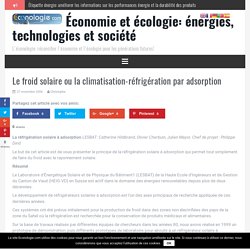
Food Storage. Coolgardie Safe, Cooling Chest Invention of the Coolgardie Safe is credited to Arthur Patrick McCormick, a contractor in Coolgardie, and later Mayor of Narrogin.
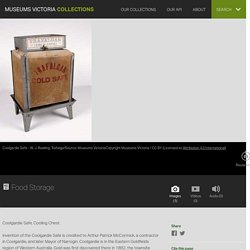
Coolgardie is in the Eastern Goldfields region of Western Australia. Gold was first discovered there in 1892, the townsite became a municipality in 1894, and by 1898 its population of 15,000 made it the third largest town in WA after Perth and Fremantle. In the last decade of the 19th century Coolgardie was the capital of the West Australian goldfields. Being 180 kilometres from the nearest civilisation, food supplies were initially scarce and expensive. Fifty buck fridge keeps your food cool without electricity. We often say that Small fridges make good cities, but perhaps tiny fridges that don't need electricity are even better.
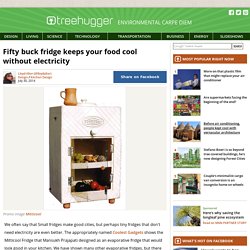
The appropriately named Coolest Gadgets shows the Mitticool Fridge that Mansukh Prajapati designed as an evaporative fridge that would look good in your kitchen. We have shown many other evaporative fridges, but there are some interesting features on this one, including the trendy plastic door that lets you see what is inside (as it allows some heat gain, there is a price on everything.) Prajapati describes how it works on the Mitticool site: Water from the upper chambers drips down the side, and gets evaporated taking away heat from the inside , leaving the chambers cool. Koozie - Wikipedia. Three examples of koozies.
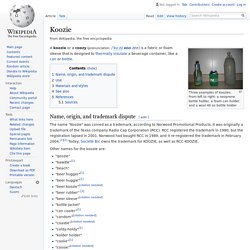
From left to right: a neoprene bottle holder, a foam can holder, and a wool 40 oz bottle holder A koozie or a coozy (pronunciation: /ˈkuːzi/ KOO-zee) is a fabric or foam sleeve that is designed to thermally insulate a beverage container, like a can or bottle. Name, origin, and trademark dispute[edit] The name "Koozie" was coined as a trademark, according to Norwood Promotional Products.
It was originally a trademark of the Texas company Radio Cap Corporation (RCC). Other names for the koozie are: Solar-powered refrigerator - Wikipedia. Evaporative cooler - Wikipedia. An evaporative cooler (also swamp cooler, desert cooler and wet air cooler) is a device that cools air through the evaporation of water. Evaporative cooling differs from typical air conditioning systems which use vapor-compression or absorption refrigeration cycles.
Evaporative cooling works by exploiting water's large enthalpy of vaporization. The temperature of dry air can be dropped significantly through the phase transition of liquid water to water vapor (evaporation), which can cool air using much less energy than refrigeration. In extremely dry climates, evaporative cooling of air has the added benefit of conditioning the air with more moisture for the comfort of building occupants. The cooling potential for evaporative cooling is dependent on the wet bulb depression, the difference between dry-bulb temperature and wet-bulb temperature. Coolgardie safe - Wikipedia. The Coolgardie safe is a low-tech food storage unit for cooling and prolonging the life of whatever edibles were kept in it.
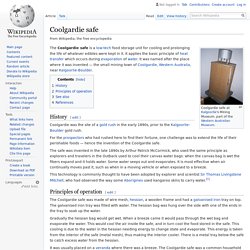
It applies the basic principle of heat transfer which occurs during evaporation of water. It was named after the place where it was invented — the small mining town of Coolgardie, Western Australia, near Kalgoorlie-Boulder. Photo of the Week: Charcoal Cooler (Cobah, Australia) Continuing the journey in Outback Australia, the photo of the week shows an early evaporative cooler used to counter the harsh heat.
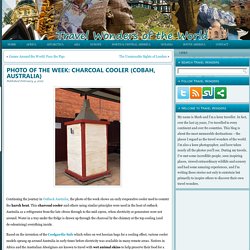
This charcoal cooler and others using similar principles were used in the heat of outback Australia as a refrigerator from the late 1800s through to the mid-1900s, when electricity or generators were not around. Water in a tray under the fridge is drawn up through the charcoal by the chimney at the top cooling (and de-odourising) everything inside. Alternative Refrigeration - Three Methods of Passive Cooling.
Passive Cooling Here are three methods of alternative refrigeration you can use without electricity.

Your best success will come using a combination of all three passive cooling methods. Having a way to refrigerate your food and “chill out” when the power goes out could be one thing to help ease the stress during a crisis. Evaporative Cooling (original) Much of the post-harvest loss of fruits and vegetables in developing countries is due to the lack of proper storage facilities.
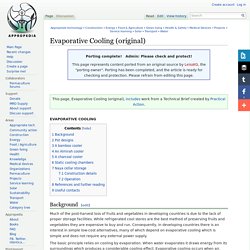
While refrigerated cool stores are the best method of preserving fruits and vegetables they are expensive to buy and run. Consequently, in developing countries there is an interest in simple low-cost alternatives, many of which depend on evaporative cooling which is simple and does not require any external power supply.
The basic principle relies on cooling by evaporation. When water evaporates it draws energy from its surroundings which produces a considerable cooling effect. Evaporative cooling occurs when air, that is not too humid, passes over a wet surface; the faster the rate of evaporation the greater the cooling. ClayTech. Food and agriculture. Infohightech.com - Présentation d'un réfrigérateur à refroidissement radiatif, modèle du docteur Yasuyuki Fujimura. Ecole d'ingénieurs du Canton de Vaud - Réfrigérateur à adsorption, Construction et test.
Cryptic Cricket - Réfrigérateur Solaire: le zeer pot. Cephes - Réfrigération passive par rayonnement, article. Toulouse, le 18 mai 2002 1962 : des chercheurs français découvraient le froid gratuit … 1982 : Daniel DEPRIS invente le mur qui produit de l’électricité … 2002 : ces découvertes n’ont jamais pu être exploitées !
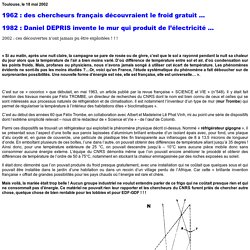
! ! « Si au matin, après une nuit claire, la campagne se pare de rosée ou de givre, c’est que le sol a rayonné pendant la nuit sa chaleur du jour alors que la température de l’air a bien moins varié. C’est sur ce « cocorico » que débutait, en mai 1963, un article publié par la revue française « SCIENCE et VIE » (n°548). C’est au début des années 60 que Félix Trombe, en collaboration avec Albert et Madeleine Lê Phat Vinh, mi au point une série de dispositifs dont l’extrême simplicité relevait – nous dit le rédacteur de « Science et Vie » - de l’œuf de Colomb. Parmi ces dispositifs se trouvait un réfrigérateur qui exploitait le phénomène physique décrit ci-dessus. Mais voilà, la mariée était trop belle ! Science et vie numero 548 - Réfrigération passive par rayonnement, Félix Trombe.
Wikipedia - Réfrigération passive par rayonnement. Un article de Wikipédia, l'encyclopédie libre.
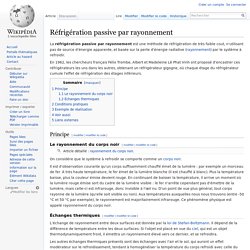
Betty Lujan - Imbreco Fridge (version française), Réfrigérateur repensé avec bon sens. Coca Cola - Bio Cooler. Entreprise Solaref - Réfrigérateur par adsorption. Il ne nécessite ni moteur, ni batterie, ni fluide frigorigène pour fonctionner.